What is Ullagami?
A few years ago my family and I moved to northern Scotland, where the winters are long and the nights seemingly without end. And so, in order to beguile the many hours of darkness, I began working with paper. I have been doing origami for over a decade, but here I quickly moved on to kirigami, fascinated by the possibilities I found available by interrupting the folded surfaces that origami generally likes to keep intact.
The parameters I set for myself were simple: each model should collapse folded flat when completed; and each model should be created from a single sheet of paper — nothing should be added or removed, but rather the surface of the paper should be rearranged without loosing a shred of its area.
Beginning with simple building-block designs, the pieces evolved further and further within the limits of my basic parameters, and my manual and mathematical abilities.
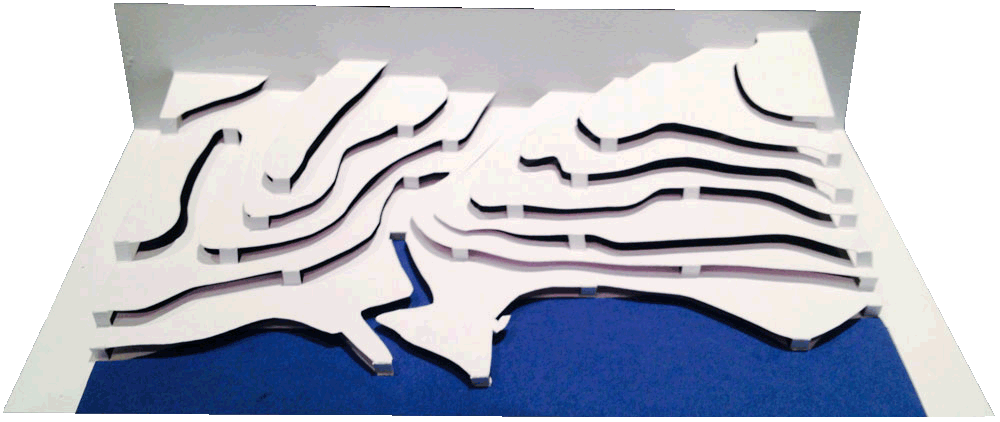
The name Ullagami is a portmanteau; it is a mixture of origami and kirigami, and because the village I live in is called Ullapool. It wasn’t until I decided to create a Japanese “chop” to stamp the backs of the pieces I was constructing that I learned, quite by surprise, that the transliteration of “ullagami” into Japanese is ウラガミ, which literally means “the back of the paper” — exactly where I wanted to put the stamp! Perfect! A very happy accident indeed.
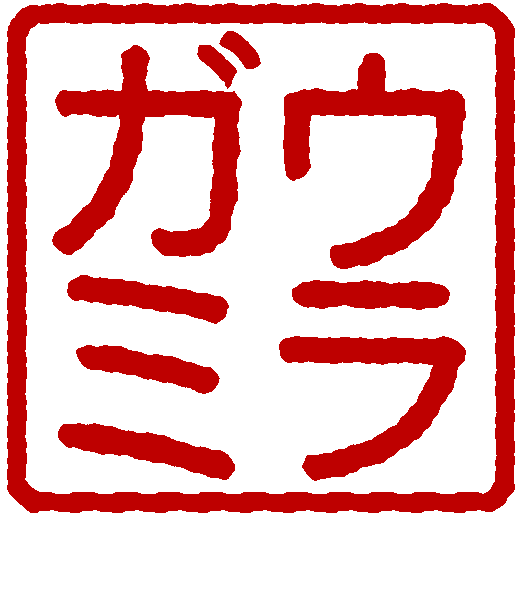
(You can imagine how hard my palm hit my forehead when I proudly showed a Japanese friend my new stamp, and she said, “That’s cute and very American. But we normally write it top-down and right-to-left.”
D’oh! So I remade the stamp. Like everything else I design: you have to cut it, evaluate it, and then cut it again right.)
Of course I soon learned that these models fall loosely into the more general category of Origamic Architecture, but since OA includes a huge variety of crafts which, though often amazing, do not match specifically with my own purely geometric approach, I use the term Ullagami instead. And besides: it’s a lot easier to say!
About Origamic Architecture
Paper is magical. It made its way to Japan as a new invention 1300 years ago, and soon afterward, as it became more affordable and accessible, origami grew into an important part of Japanese culture. There it developed mostly in isolation for a long time, set away from the academic mathematical innovations that were occurring in the Western and Near-Eastern worlds. There is some evidence that Europeans experimented with paper folding in the 1400s, but nothing on the scale or interest level of what Japanese had been doing at that point for centuries.
In the 1800s, as European artistic culture advanced, paper folding started to spread as a handicraft, and to catch the eye of some of the creative giants of the day. Still it was mostly only used as an exercise, a kind of pedagogical stepping stone to other concepts, rather than an art form in its own right. Then, in the mid-20th century, two things happened, or should I say, two people. Akira Yoshizawa standardized origami diagram notation, invented new and innovative ways of folding, and also actively evangelized the form. Origami was getting worldwide recognition. And Masahiro Chatani followed. It was Chatani, an architecture professor in Tokyo, who added cutting into the folding art, popping up both figurative and geometric structures, and pioneered what is now known as Origamic Architecture. He published more than 50 books.
Since then, and especially in recent decades, origami and mathematics have joined in lots of interesting ways, particularly in terms of abstract paperfolding, where the model isn’t a bird or a flower, but instead reveals pure shapes and mathematical forms. I spent literally hundreds of hours in my younger days with Tomato Fuse’s modular origami books, using the geometry of flat paper to bring out other, more complex surfaces, in celebration of nothing more or less than intricate and interesting polyhedra.
And now with social media and so many other dedicated origami forums and pages, there has been, it seems, another explosion in interest in folded forms, as people who once folded in isolation can share and exchange images and ideas. It’s amazing what people are making these days.
I mentioned Chatani and Origamic Architecture. His pop-up models were very often quite figurative. Buildings and houses, greeting cards, flowers. But he also designed and published numerous patterns for more abstract pieces, pop-ups based on pure math and geometry, and very beautiful they are, too. Since his death, however, the world of OA has continued to evolve mostly in the former direction, and not so much in the latter. People are cutting and folding incredible things under the rubric of OA, but almost always figurative, leaving the more abstract branch of the tree largely untended.
And that’s the branch that interests and fascinates me, which I shake in search of fresh fruit. All my models start with a single sheet, and end with a single sheet; nothing is added or removed, the paper is merely slightly rearranged. And the geometric forms that can be coaxed out of a flat surface continue to amaze me.
So my very long-winded point is that there has been a conversation happening, a dialogue about folding paper, for more than a thousand years. During that conversation, ideas have been exchanged, digested and synthesized, other disciplines and cultural understanding have been absorbed and incorporated, as the history of papercrafting has evolved with all its many facets into the modern world. I am doing something which, I hope, advances that conversation, helps to push it in an interesting and neglected direction, and I want as many people as possible to see it, even as I keep inventing it, so that into the future others might pick up the thread and take it in new, even more interesting directions. I want to participate.
How I Design
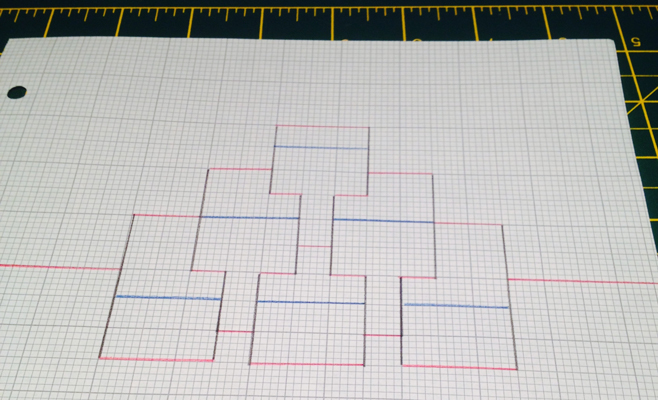
When I started exploring, my design tools were basic: a red pencil, a blue pencil, a regular pencil, and some graph paper. I figured out the templates in 2D, starting from the most basic principles and building blocks, then cut them, folded them up, and learned from my mistakes before starting over. But as this method requires slashing all my calculations to bits in the act of cutting them, I quickly moved to Adobe Illustrator. I used it just the same, like digital graph paper, only with the advantage that I could print my templates out, fold them, change them, and print again.
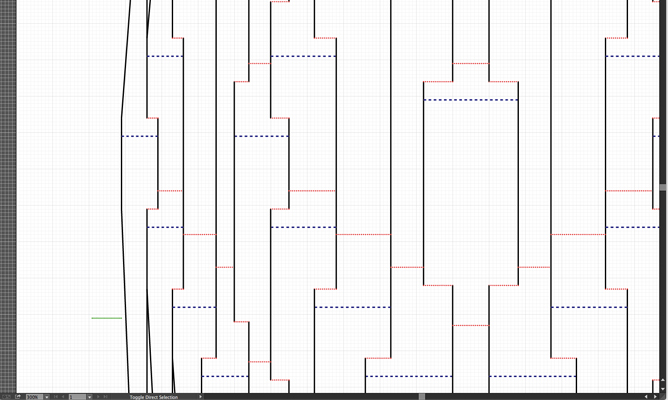
Before too long I was writing simple scripts in Illustrator, to automate what mathematically repetitve portions of my design process I could. Eventually though, even that began to show some serious limitations, and so I ultimately buckled down and wrote a whole new piece of software from scratch, iteratively codifying my gathered intuitions into an environment where I could design algorithms, functions and graphs, code them into my framework, and then manipulate the results before cutting and folding by hand.
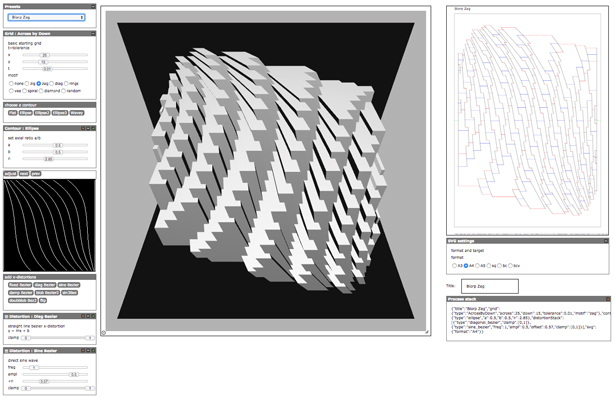
This system clears the way to focusing more purely on the mathematics of form, within the limits of a sheet of paper. Algorithmically it's nothing too fancy, relying mostly on high-school math: algebra, lots of trig, basic calculus, and matrices. My son, 16 years old at the time, is an absolute whiz, and keeping up with his homework helped me rekindle long-forgotten ideas, which I try to translate into new designs.
It's all been very educational.
For a deeper dive into my iterative design process, click here
Tools and Materials
People often ask about the tools I use to make my models. So here is a quick rundown, many of which items also link to where you can find them for purchase. These are my opinions; please use these preferences only as a general guide. Everyone likes to choose whatever works best for them.
Over the years, I have grown increasingly picky about my tools. It's very much personal taste, of course, but for my money, there's no better blade than the Olfa Art Knife. It feels better in the hand than any Xacto or Swann Morton scalpel I have ever tried, it's well-made and doesn't slip. Leave it to the Japanese to make a good kirigami tool, right?
The rest of my tools are pretty basic. A Staedtler 30cm ruler, and another at 20cm, keep my lines neat and straight. For crisp creases and small details I rely heavily on a pointed awl to act as a very sharp surrogate fingertip. This is my #1 folding tool; I'd be lost without it. And the counterpart to that is a good pair of ESD-13 tweezers, to help reach and pinch into tiny places.
For what it's worth, I've experimented quite a lot with cutting mats as well. And while there is a great number of different companies making rubber self-healing mats of varying hardnesses and durabilities, I keep going back to the Humbrol Cutting Mat. It's red in the US, but grey in the UK for some reason, but either way the blade feels good against it, with just the right amount of frictional resistance.
But more than anything, I get asked – a lot – what kind of paper I like to use.
For white, I prefer Daler-Rowney 160gsm Fine-Grain Cartridge paper. It's a warm white with a very gentle texture and catches the light well. It takes a crease beautifully, but is also relatively forgiving, and is rigid enough to support its own weight at the sizes I design for. It's generally not available in the US, though, so when I am in the States I use Canson Mix Media 98lb paper, which has a very similar feel in terms of density and fiber.
For color, I also like Daler Rowney's Canford papers. At 150gsm it's a tiny bit lighter than the cartridge, and smoother, and folds up very neatly.
For 90° black and white pieces, I build my frames out of black mounting board, which I hinge with cloth bookbinding tape on the outside, and black washi tape on the interior. I'm not much of a bookbinder, but it works.
The grander answer, however, is that you can make my designs out of most any kind of paper, so long as it isn't so floppy that it can't support the weight of the model. Even normal copy paper, for smaller models, will work. And it's not only about paper: I and others have experimented, cutting, etching, or otherwise constructing my templates out of tree bark, cork (I know, it's another kind of tree bark), shrinky-dink, photographs, even copper sheet. Ultimately, though, I'm always most impressed with the simplicity and versatility of paper as a medium.
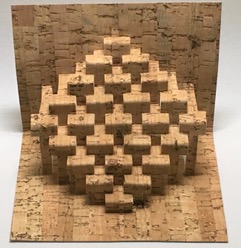
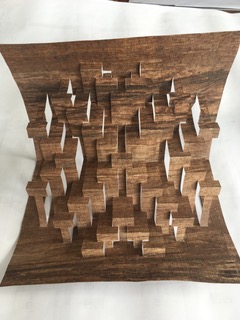
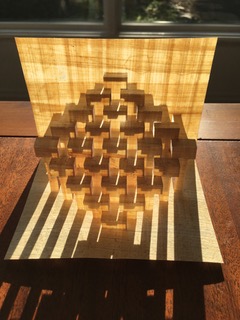
.jpg)
.jpg)
.jpg)
And if you're an engineer with an idea for how to make entire pop-up stadium buildings out of my designs, get in touch!
